Text
12/07/2023-02/03/2024
Over this period of time I read the books I had that are continuations of things I had been reading. I am not sure how much I have to say about any of them, hence the delay between finishing them and posting this.

I started with volume 3 of BRZRKR written by Keanu Reeves and Matt Kindt, art by Ron Garney, and colors by Bill Crabtree. I read the first two volumes recently and wanted to see how it wrapped up. I was worried about forgetting things in the mean time. I did, but while I read the final volume, what I forgot didn’t seem much worth remembering. The story was all in broad strokes. It wrapped up a plot about one employers of Unute and Diana, while leaving them to start a miraculous family with two quickly gestating and growing fraternal twins. It ends in space in a way sets up a new beginning. I don’t think I care enough to continue. I still like the art, but by now I feel cynical about this opening to a franchise.
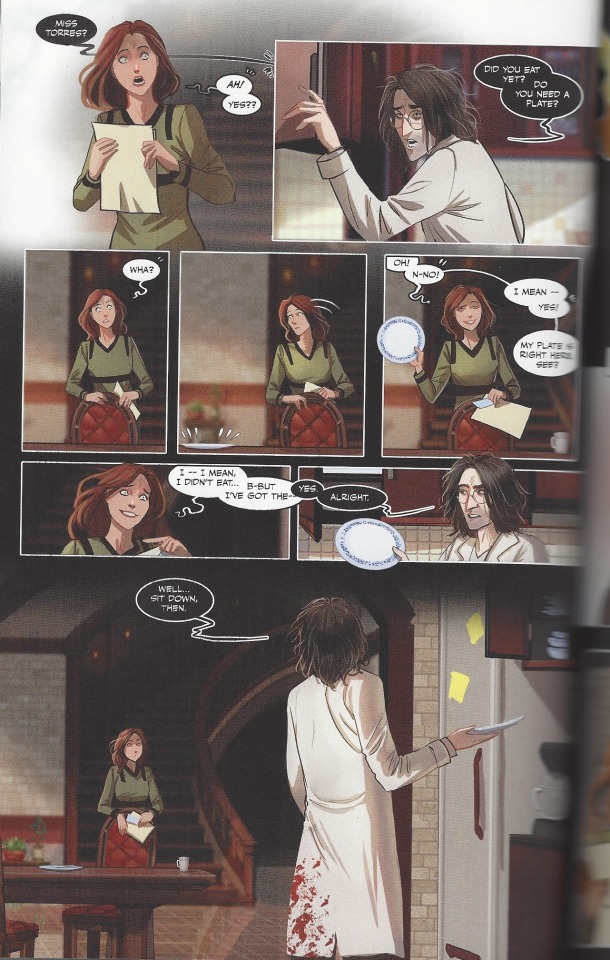
My normal way for choosing what to read is to prioritize wha I started the longest ago first. If I kept with this, I would have read Blood Stain 4 writing and art by Linda Sejic before BRZRKR 3. There has been six years between volumes, and I still haven’t gotten my to read piles down enough to re-read the first three. This is the only series that I haven’t written about here, as I wasn’t trying to do these kinds of updates when he las one arrived. It is also the one I enjoyed reading the most. I definitely forgot a lot of the plot, but there hadn’t been much of it. A throw away bit of dialogue in this volume worked as a reminder that the previous volumes only took place over a few days. The lead character, Elliot Torres only is confirmed to get the job as Vlad Stein’s assistant in this volume. On a related note, the previous volumes all had comedic material the back involving the characters in non-plot related situations, that show a level of familiarity that they hadn’t reached in the plot. This one didn’t. If anything, it did a lot to make up for time lost as far plot points go. We learn about about Torres’s adjustment to her new work/life balance, and more about the working Stein’s actual life here than I think we did ever before. Stein becomes a lot more human, despite all the other worldly or vampiric signatories around him, including how his text bubbles are black with white text, like the Sandman himself. I liked it the most of these reads. It’s pleasant and friendly and seems to exist just for itself. I also like the art, which combines reality and fantasy very well in a way that feels like they inform each other. It’s lovely.
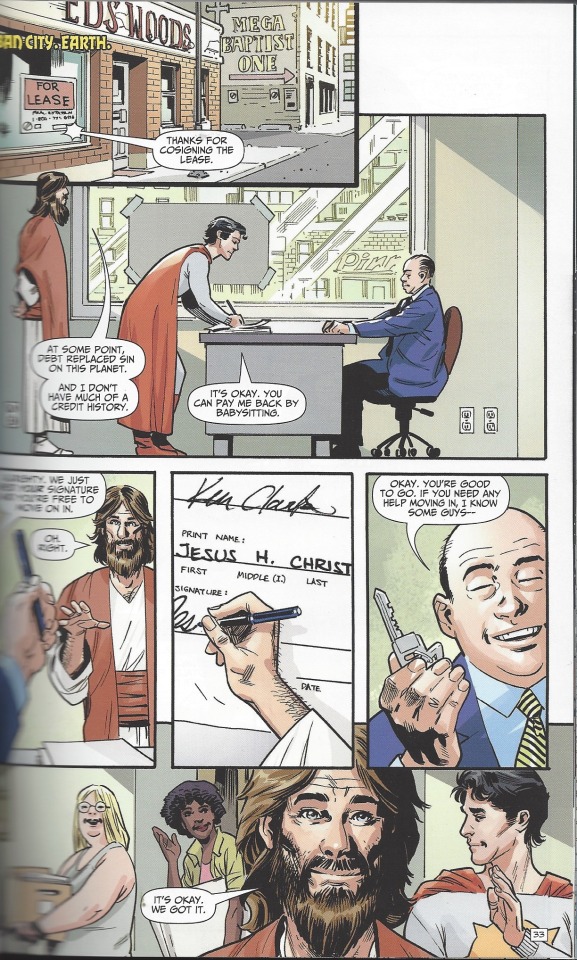
Finally, I read Second Coming Trinity, the aptly named third volume of Second Coming. It is written by Mark Russell, art by Leonard Kirk and colors by Richard Pace. I read the firs two volumes way back in 2021 and I remember mostly liking them and being okay with the way the Jesus and Superman become roommates situation. But I forgot most of the plot including everything about the Lex Luther/Brainiac villain Cranius. This one is about the affect that Sunstar’s son, brining up examples of how both Sunstar and Jesus were dangerous super powered kids in their youth. Also there is an issue where it turns out God is disappointed in the human art market. Me too, but this just irked. The volume ended with a cliff hanger. Everything in the volume led to it. And yet I still feel like the creators bit off more than they can chew. It’s Sunstar flashbacks have a combination of “Super dickery” and “Man of Steel, Woman of Kleenex” that feels too related to the writing about Superman over the decades to be a stand alone story. Jesus starts his own church to have a more direct control over his message, but that has worldly complications. We get to meet more of this world’s versions of Justice League characters, which mostly left me wondering why?
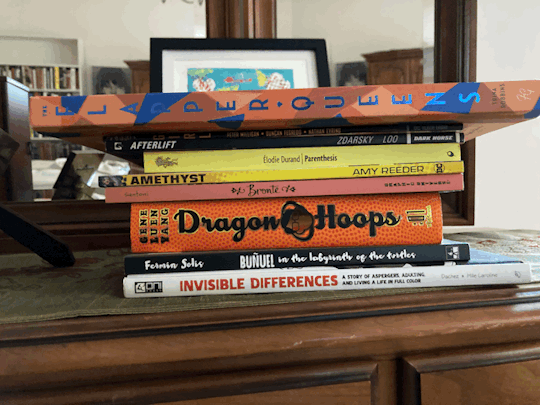
I have started y next comic book pile since finishing this. I am in a slow to read historic comics. I will update when I am ready.
#comic books#what i'm reading#image comics#comics#boom studios#ahoy comics#brzrkr#keanu reeves#matt kindt#Ron Garney#bill crabtree#Blood Stain#linda sejic#Second Coming#Second Coming Trinity#mark russell#leonard kirk#richard pace
2 notes
·
View notes
Text
Comics Read 12/01-06/2023
Over this time period I read Saga volume 11 with art by Fiona Staples and written by Brian K. Vaughan. You may look at the dates and think, that was a month ago, why are you writing and publishing this now? Well, it’s been a long and busy month. At first I thought I would read some of the other recently purchased comics that are continuations of series I have been reading for a while and write about them together. But then I really didn’t have much time for reading.
It’s worth mentioning that the ten years I’ve been reading Saga is the longest period of time in which I’ve ever read a comic while it was ongoing. This is probably even true if you don’t count the three and a half year hiatus. And unlike many of the other comics I’ve read over this time it’s one where I have a decent memory of the various supporting characters. It’s wild to think what is all this about.
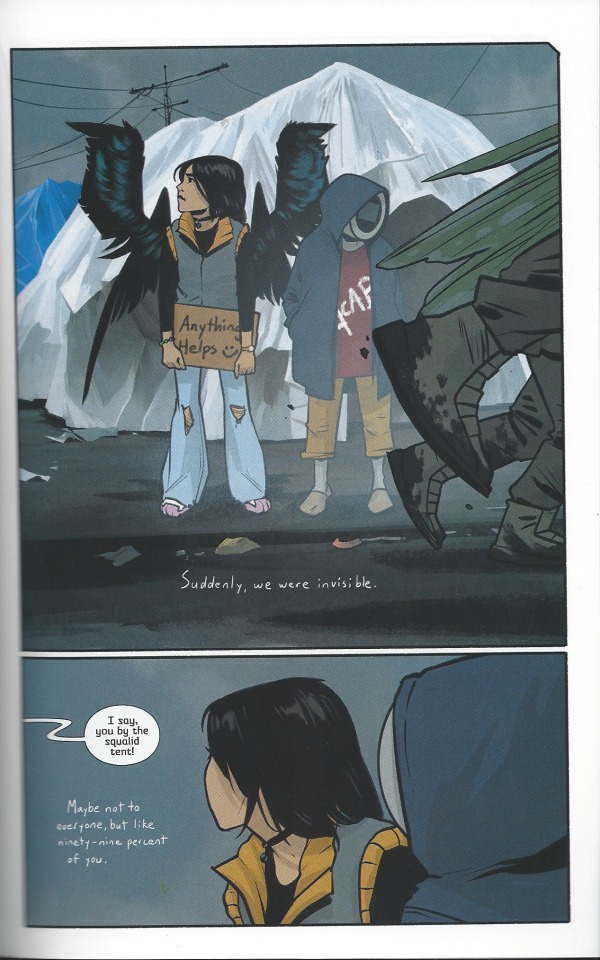
I can’t believe there was over a year since the last trade paperback. That one, (and the previous pre multi year hiatus one), had a world shattering cliffhanger. This one does not have as devastating cliff hanger, but it does have plenty of heartbreak. At this point, our protagonists are two fatherless children and a working but broke mother. It’s rough, but its also always entertaining. We got to see more of the reoccurring characters both from early and more recent issues, continuing how the Saga is just how many people this family on the fringes affects. As always, the art is great with distinct character designs and drawings filled with details that are vulgar, humorous, and sweet.
During this reading I thought the never ending conflict between the Wreath and Landfall feels like it’s going to be taken as a more literal metaphor now than when I started reading it. This troubled me. I don’t think any direct metaphors are intentional. In it’s fiction it insists on nuance often lost in our real world conversations. But this won’t work for everyone. Considering these issues include a segment about how Hazel and Squire don’t like, and are mostly bothered by some problematic word choices in D. Oswald Heist’s A Nighttime Smoke, the novel that bonded Marko and Alana, maybe the creators of Saga expect something like this?
1 note
·
View note
Text
Comics Read 11/10- 17/2023
Over this time period I read Friday written by Ed Brubaker, art by Marcos Martín and colors by Musta Vicente. Originally published only by the Panel Syndicate, the print edition I read was published by Image Comics. Brubaker is, of course, also the writer Fatale, the comic I started to re-read and analyze for this blog and then abandoned with vague plans to return to it. I still might, and this sort of made me wish to return to it as it also touches on cosmic horrors.
I don’t know what I was expecting when I started this. I am familiar with Brubaker and Martín’s work, so I didn’t look into it’s plot when selecting it for a read. I was just going along for the surprise. Still, I did not expect the combination of Young Adult mystery with cosmic horrors and time travel. I think I liked it. I definitely want to know what is next.

The story concerns a young woman named Friday Fitzhugh, who is just home to King’s Hill for the winter holidays after her first semester in college. Her best friend is a boy named Lancelot (Lance) Jones, who is the town’s genius. Over the years their set up has been he’d solve mysteries while she’d be his assistant/body guard. Things where getting uncomfortable between Friday and Lance before she left, though she’d have a hard time articulating why. As soon as she gets back, he enlists her in rounding up one of their usual suspects. Only their usual suspect seems spooked by something supernatural. Things escalate from there, taking Lancelot out of action for the second volume at least.
Despite having read many comics that Martín has drawn over the years, this felt somewhat different. His style seems to be changing. I’d describe his previous style as an acquired taste, but I have not yet acquired a taste for this one. The character design for Friday sometimes felt like she should be in images where she was extremely foreshortened even when that wasn’t the case. Aside from this, I liked the two page spread that were done to help fill in Friday and Lance’s past, the history of the town, et al.

In the back matter Brubaker discussed wanting to evoke the YA novels of the 1970s that influence it. I see that influence in the fashion and colors, (when they are not also evoking the more dream like aspects of the story). Despite the supernatural elements, this is a tale of disillusionment, the way that some people associate the 1970s in relation to the 1960s. Friday and Lancelot’s adventures were all about the fun of being smarter than their age when they were kids. By the time this story takes place, it’s also about how the adults can’t protect them either because of ineptitude or or corruption. That said, Friday has two interracial mothers, and that seems to be well accepted in this small town, and I don’t know if I’d buy it in this time period. Anyway, I do want to read more of this post-YA fantastical 1970s fashioned world.
#comic books#what i'm reading#image comics#the panel syndicate#Friday#ed brubaker#Marcos Martín#Musta Vicente
2 notes
·
View notes
Text
Comics Read 10/14-11/02/2023
I recently read the first two volumes of The Nice House on the Lake written by James Tyrion IV, with art by Álvaro Martínez Bueno and colors by Jordie Bellaire. I have been reading Tyrion for a while, and Bellaire’s colors are familiar, the work of Martínez Bueno is new to me. I decided to read it based on liking Tyrion’s other work, which was good decision!
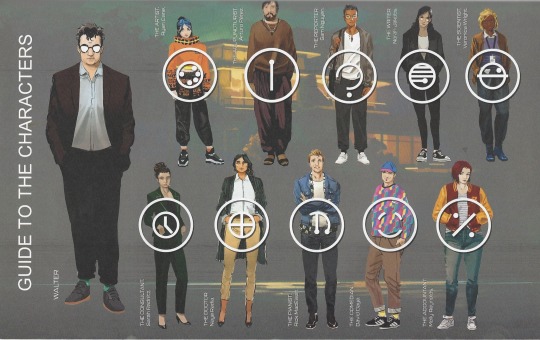
The Nice House on the Lake is about a bunch of people who all share a friend in a guy named Walter. Only it turns out that Walter is an alien from a species that has decided to wipe out most of humanity, except for some segregated groups of ten, who will prove that they can live in harmony unlike the rest. Here it is important to note that we do not see any of the other groups of ten that other members of Walter’s species selected in this volume, and also there are more than ten in this group. Walter invited his hand selected favorite people to survive the destruction of the world in a cabin near Milwaukee. These friends are from various phases in life, high school, college, and just hanging around New York City. They don’t know each other well and between that and the shock of that’s happened they are doomed from the start. Helpfully, both volumes come with a not quite complete character guide in their back matter.
Each issue is introduced by one of the characters narrating directly to reader, some time after the main narrative, when the idyllic isolation of the house has ended and the apocalypse has become a regular part of their lives. The two volumes presented here do not bring us to that point yet, but I am interested in getting there. What I have read reminds me a bit of Tyrion’s earlier comic book, The Woods, which I liked, and I am willing to say that this is better. Early on, it also reminded me of the Vertigo series Unfollowed, but considering what a misanthropic mess that turned into, it is probably for the best that I stoped being reminded of it.

The speaker at the beginning of the issue also shares flashbacks illuminating their one-on-one personal relationships with Walter. These always involve multi-panel two page spreads. I bring this up because the multi-panel two page spreads in comics are pretty unusual. Having them become a regular part of this comic’s formula is destabilizing, like the characters existence.
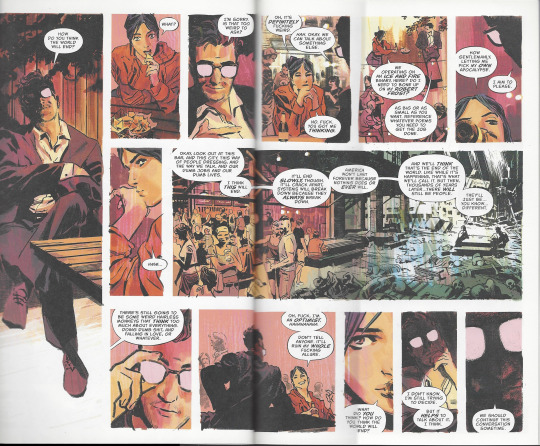
Near the end of the first volume it’s revealed that Walter is capable of altering his friends’ memories, and has been doing so for a while. It turns out, some of them have had more to do with building this cabin and it’s rules than they are comfortable with consciously knowing. This leads to the second volume having something of a reset. The format is slightly tweaked and things rush toward a scenario where maybe the characters will have more control over their lives.
As I said earlier, I was unfamiliar with Martínez Bueno’s work coming into this, but now I can say that I am a fan. His work is sharp, but with a sense of wash giving an easy to read sense of movement. It could be water color, but in an almost impossibly controlled way. He designed Walter to wears glasses that block the view of his eyes, even in his shifty alien form. However, there are other characters who also wear glasses where their eyes are clearly visible behind them. A great way to constantly remind the readers that he’s not quite who he says he is. My only complaint about the character design is that two of the female characters, Norah and Sarah, are a little too similar in appearance, a fact not helped by both characters being chain smokers. But most importantly the house of the title really does look like it would be an awesome place. That is, If it weren’t for the circumstances surrounding everything.
#what i'm reading#the nice house on the lake#james tynion iv#Álvaro Martínez Bueno#jordie bellaire#dc black label#dc comics black label#comicbooks
0 notes
Text
Comics Read 09/22- 10/05/2023
I read the first two volumes of BRZKR written by Keanu Reeves and Matt Kindt, art by Ron Garney, and colors by Bill Crabtree. It’s Keanu Reeves’s first foray into writing comics and there is reason to read it as something that relates to his career as an actor/movie star. In some of the art and a lot of the variant covers the lead character is drawn to explicitly evoke Reeves.

The leading character, known alternately as Unute and B, is an immortal fighting machine. He was conceived through the prayers of his mother to help protect their prehistoric village. Then her husband used him as a tool against their enemies and potential enemies. Throughout history he has been used by those who want his awesome violence. The effect is dehumanizing. He is valued as a tool, not a person with agency (an actor). In the present day, he alternates between doing his Berzerking thing and trying to understand who and what he is. The latter involves a combination of cutting edge scientific tests and talk therapy with a Dr. Diana. Diana’s motives may be loving and even altruistic, but her employers are not, which leads to the cliffhanger ending of volume two.
Now I am going to segue into Reeves’s co writer, Matt Kindt, who I have previously written about pretty recently. While I can only speculate about Reeves’s interests, as someone who has read more than a little of Kindt’s creator owned work, I feel I more inclined to say where I see it, or don’t, here. The various organizations that use B are not unlike those in Mind MGMT or Super Spy in the disregard for their employees as people. Kindt also likes plots that jump around in time as the flashback structure here allows it to do. However, Kindt’s interest in memory is more about the subjectivity of experience than anything present here.
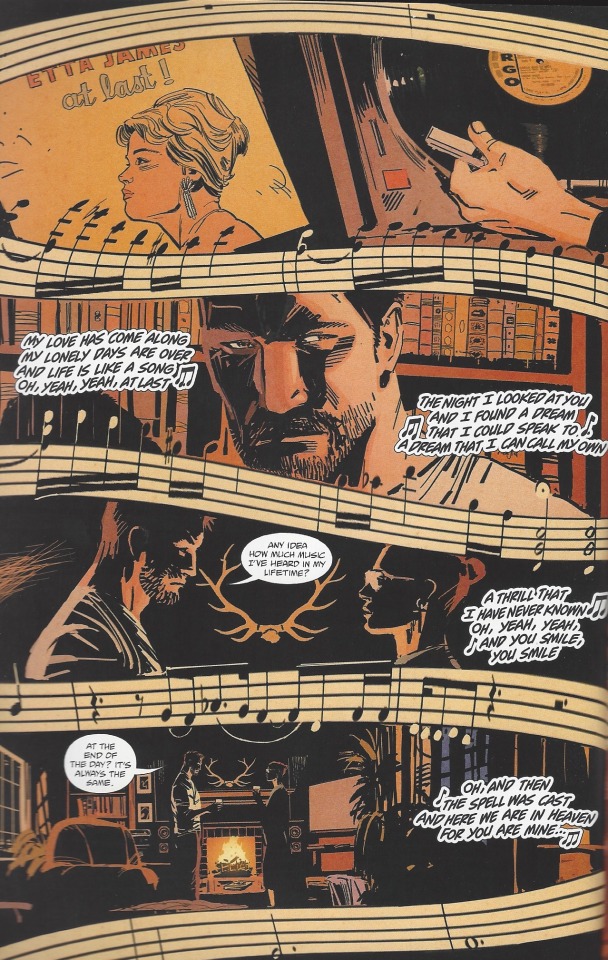
I don’t think I have ever read anything with art by Ron Garney before this. Asides from making the lead character look like one of the co-writers, I generally like what he’s done. He has a lot of distinct character designs, handles different time periods well, including have to balance primitive and futuristic technology. I am struggling to say with which other artists I would group his work. Maybe Becky Cloonan? Goran Sudžuka? Michael Lark? I am struggling to think of terms to the define these artists similar styles. Maybe line based and more round than angular. I also have to praise Bill Crabtree for having things be either warm or cold, though sometimes at the same time. It was an effective treatment of this dehumanizing lifestyle.
While reading, I suddenly was reminded of Ales Kot's Zero a comic of which I literally only read one issue many years ago and decided I didn’t like it enough to continue. But that’s where my brain went, mostly because of the early issues structure, where the main male character is engaging in extremely violent actions while a woman and a male (in BRZKR it’s the main male at another moment in time, in Zero it’s someone else) analyze and comment on it. I bring this up near the end to say that while I’d like to read the conclusion of this arc, I am not interested in it as an ongoing franchise, as the current, spinoff series, BRZKR Bloodlines suggests there will be.
#comic books#what i'm reading#boom! studios#brzrkr#boom studios#keaunu reeves#matt kindt#ron garney#bill crabtree#comics
2 notes
·
View notes
Text
Comics Read 09/07-18/2023
Over this period I read Serial written and drawn by Terry Moore. Earlier this year I read Moore’s Ever, and in my post about it I mentioned that I would use my read of the already purchased Serial to decide whether or not to continue with the Terry Moore universe. I liked Serial more than Ever, but I still think it’s time for an indefinite hiatus from this universe. The fact that his current series is titled and about the Parker Girls does nothing to sway this decision. There weren’t any direct references to the Parker Girls in Serial (though there was a panel in which a character was misnamed Mrs. Parker, when the rest of the time she’s Mrs. Baker) but I still don’t think I like the direction enough to continue.

The story involves Zoe, the immortal murderous being in the body of a forever ten year old girl introduced in Rachel Rising. HereZoe finds herself on the trail of Jenni, a vigilante going after mostly pedophiliac men. Her kill list includes the wife of one, who happens to be a friend of Zoe’s from another life. By Jenni’s estimation she must have known about her husband and been an abuser too, or at least an enabler. Zoe disagrees, despite the fact that she had not been in touch with her friend for years.
There weren’t additional characters from other parts of the Terry Moore verse, (at least none that I recognized) but it was distinctly of the universe. The plots’s various backstories of childhood abuse are mostly excuses for these two women to get very violent. Attraction to images of women acting violently has always been a motivating factor for what gets Moore to make comics. During the climactic fight Zoe and Jenni argue about whether they have anything in common. Jenni declares that they do, but Zoe insists that they don’t. However, the only argument that Zoe offers that seemed to hold weight for me was pointing out that unlike her, Jenni didn’t have a sense of humor. I have to admit that I didn’t find any of the jokes Zoe cracked during their fight funny either, but she did make them. I am not sure Moore really has a side in this debate about his murderous characters. Ultimately, I don’t think the abuse described to justify the violence feels worth evoking for foddering this plot. Jenni’s anger is somewhat righteous, (even if her vigilantism is indefensible) but Moore undermines it with things like giving a lot of space to her abusers interpretation of their time together. He might have been going for some kind of ambiguity, but mostly just comes off as a sensationalist who should think of creating some limits to apply to himself.
The book does feel like an advance in Moore’s drawing, which includes some beautiful nature scenes and creative use of shading. But it also feels like a return to the anything goes, directionless parts of Strangers in Paradise, and I’m not feeling up for the ride.
#what i’m reading#comic books#Terry Moore#Serial#Strangers in Paradise#parker girls#Ever#Abstract Comics#rachel rising
2 notes
·
View notes
Text
Comics Read 08/27- 09/01/2023
The original Mind MGMT written and drawn by Matt Kindt is one of my favorite comic books ever. Reading it was immersive in a way I didn’t think was possible. So naturally I had to get and read Mind MGMT Bootleg. Matt Kindt is still the writer, but here he is joined by an assortment of artists, each drawing an individual issue. In the order of the issue they worked on the artists are Farel Dalrymple, Matt Lesniewski, David Rubín and Jill Thompson. Thompson is the only one with whom I was familiar before reading this. They all have distinct styles, and they all do well with the stories that they are given.
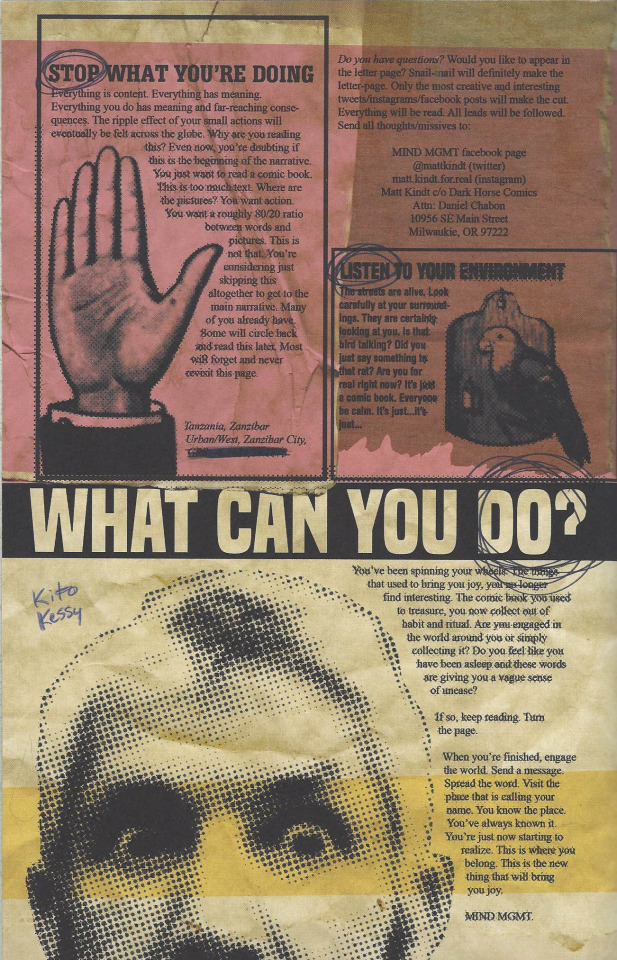
One of the reasons the original Mind MGMT is so exciting is by how it takes advantage of the format. This included having notes in the margins of the pages, some of which suggested something suspicions about the paper it was printed on, while other pages gave instructions for some kind of impossible craft. This all feels very personal for the writer, and I would imagine the creator. Would something like this carry over when they writer shares his duties with more artists? The answers is sort of. There are not those types of digressions in the sections with the various artists. However, after the main issues there his a script “sample” for people who want to understand how comics get made. Only the scenes in the scripts aren’t actually scenes in the issues and some of the instructions to the are written as if they were within the world of Mind MGMT. Also there are a small, short back of the issue comics that I believe were drawn by Kindt, though they don’t seem to get a distinct credit. (Eventually they’re revealed to be by one of the new characters.)
The plot of Mind MGMT Bootleg involves an attempt to relaunch Mind MGMT, the agency, while also relaunching the comic book series. The agency from the original series was corrupt and dehumanizing to it’s various employees, some of whom return here. But, it seems there are threats right now, such as the amount of pessimism and disinformation out there, that could use the products created by Mind MGMT to combat them. Which leads me, the reader, to have to ask myself; How much do I actually want a relaunch of Mind MGMT?
I didn’t like Kindt’s follow up series as writer and artist, Dept.H as much as I liked Mind MGMT. But I don’t like never ending franchise. There has to be a better reason to go there.
#Mind MGMT#Mind MGMT Bootleg#matt kindt#Farel Dalrymple#Matt Lesniewski#David Rubín#Jill Thompson#dark horse comics#Comic books#what i’m reading
0 notes
Text
Comics Read 08/13- 20/2023
Over this period I of time I read Rockstars written by Joe Harris, art by Megan Hutchison-Cates, colors by Kelly Fitzpatrick, designer Tom Muller, letters by Michael David Thomas, and edited by Shawna Gor. The edition I read this time was Rockstars The Complete Series as published by Vault. Years ago I read the first arc, “Nativity in Black Light”, in the trade paperback as published by Image Comics. I intended to get the second arc’s trade paperback, “Children of the Beast” as published by Image, but somehow missed it. Anyway, I am glad I got this edition as it encouraged by to reread the first arc which I otherwise remember next to nothing about. The page I scanned to illustrate this post, with its myriad references to our world’s rock ’n’ roll icons and legends may be the part I most clearly remember.
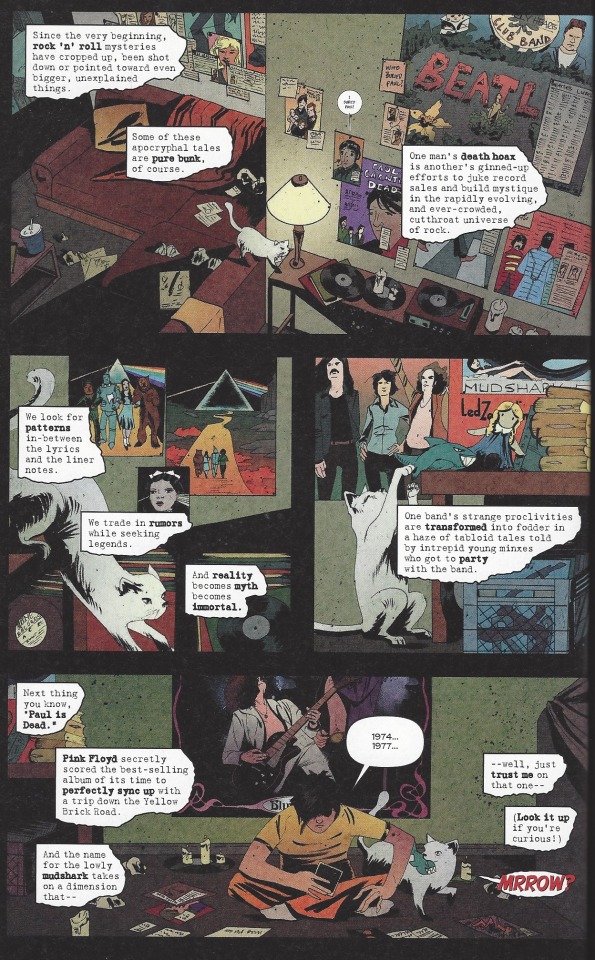
A quick search on my tags reveals I have never written about Joe Harris on this blog. This really emphasizes how long it has been since I have read any of his work. I have been writing about all the comic books I read for the better part of four years, and even though I was reading most of what he wrote for a while, none of it was during this time! I first became aware of Harris around 2013, when I was preparing to attend my first New York Comic Con. I went to a signing at Forbidden Planet the same week to get some comic books signed. There were four comic makers there. For some reason I now only remember the two that I was not there to see. One of them was Joe Harris, who at the time was primarily promoting his The X-Files season 10 comics (before the revival meant there was a tenth season of the television show). I have a complicated relationship to TXF. It was the first show I really obsessed over, it’s the first I feel angrily disillusioned over. I’m writing something about it in my other Tumblr for the anniversary. That night, I bought the trade paperback Great Pacific, one of Harris’s other creator owned comics. I liked it a lot and started following his creator owned output. I bring this up because the lead characters of Rockstars, Jackie and Dorothy, have a Mulder and Scully-esque dynamic. Jackie is driven by his family history and seeks answers through mystical uses of cards. Dorothy is a journalist, and seeks answers that she can safely publish. These two character arcs were not really developed enough either of them, but Jackie gets to a more interesting crossroads.
More directly relevant to this book, between reading the first arc the first time and reading this all now, I have steeped myself more in rock ’n’ roll legends than I was doing the first time around. Among other things I watched Brian De Palma’s The Phantom of the Paradise which reminded me about how often Faustian bargains and early death have been staples of rock legends since nearly the beginning. The plane crash that killed Buddy Holly, Ritchie Valens and “The Big Bopper” J. P. Richardson pretty much solidified this. This event is included in Rockstars, though the way is in questionable taste. (Coincidentally, that plane crash was also important to the plot of a famous episode of TXF.)
The plot of Rockstars, starts with investigating the mysterious deaths of a couple of groupies decades apart. There are ghost gangs of the groupies interfering with the investigation and they tend to be herald by the wrong lyrics of famous songs. The deaths of the murdered ones are related to demonic champions of the bands. Each arc covers a different demon in relation to a different band. The first band is an arch-typical second wave British invasion bad from the 1970s, and the second is arch-typical early hair metal band from the 1980s. I am more familiar with the former than the latter, despite actually living through parts of the 1980s. The plot didn’t really add up for me. But I love a lot of the details in the drawings, nods to famous theories and art. I also am touched by the concept of how generations are bonded because we each go through the same cycles of cultural events. I just wish that Dorothy’s character design wasn’t so close to some of the groupies in flashbacks or ghost form. It was needlessly confusing.
I feel like, of what I have read, the best comic books about loving music are Kieron Gillan and Jamie McKelvie’s Phonogram and The Wicked + The Divine. This isn’t like either of those, and that is a good thing. For all it’s flaws, I wish there was more of it.
#what i’m reading#comic books#comics#image comics#vault comics#RockStars#Joe Harris#Megan Hutchison-Cates#Kelly Fitzpatrick#Tom Muller#Michael David Thomas#Shawna Gor#nycc13#NYCC memories#The X-Files#Mulder and Scully
0 notes
Text
Comics Read 07/21-08/04/2023
Over this time period I read Papaya Salad written and drawn by Elisa Macellari. It is one of many comic books I bought because I saw it under the preordering option in the Midtown Comics app and was intrigued. I liked the title and was under the impression that it was a memoir, and I have good associations with comic book memoirs. It is not a first hand memoir. Macellari, who is half Italian and half Thai is describing the memories of a Thai great uncle named Sompong. The framing device has her as a child hearing these stories for the first time over an extended family dinner in Thailand. In a note to the reader she lets us know that the tale as presented has been augmented by a diary she read after his death.
All the colors in this book are at a low saturation. This is surprisingly effective in describing both hot and cold climates. The narrative structure of having the person who lived the events sharing them with the writer when she was a child creates a sense of living and shared memory that I really liked. The drawings are sophisticated but stylized. The incorporation of ancient Thai art styles really worked with it. There were multiple times while reading that I was impressed by the emotions its use of negative space evoked.
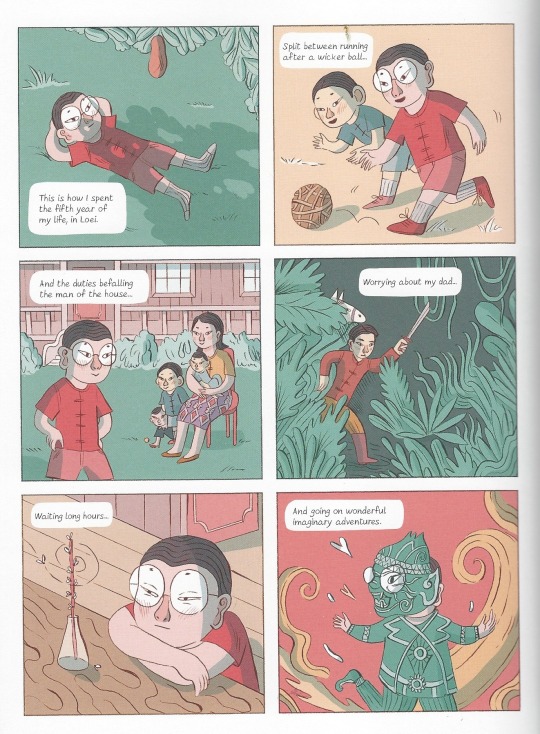
I must confess that I am pretty ignorant of Thailand’s history. While reading this, I wished I had some background of political contexts of Sompong’s personal history. For part of his childhood, Sompong, his mother and siblings moved to an obscure part of the rural countryside while his father was involved with a political conflict that I know nothing about. I also have no idea why Thai military student getting to study abroad opportunity in the late 1930s would be stationed with members of the Axis in World War 2. But mostly that did not interfere with my enjoyment of the story. It’s a great uncle share his life with someone two generations and partially from a different country. For that alone it’s worth reading.
0 notes
Text
Comics Read 07/01-15/2023
A little over a year ago I did a post about reading two comic book biographies of Artemisia Gentileschi back-to-back. I wrote some lines about how the inclusion of them in my collection helps makes the act of collecting semi-autobiographical. Consider this a sequel to that post.
Over the two weeks I am writing about I read Glass Town written and drawn by Isabel Greenberg and The Brontës Infernal Angria written by Craig Hurd-McKenney and art by Rick Geary. Different takes on the same subject, how the Brontë children had a shared alternate universe which they all wrote stories about. I have owned a copy ofThe Juvenilia of Jane Austen and Charlotte Brontë from when I was a child, but I never read it. I probably should. The names of Angria and Gondal were familiar from reading about the Brontës. But because of not actually reading the Juvenilia, I first encountered Glass Town by name in Die, where it was treated as a proto-multi-player role playing game. Which, seems fair enough. Die wasn’t much interested in the subject of their writings, so this is all new to me.
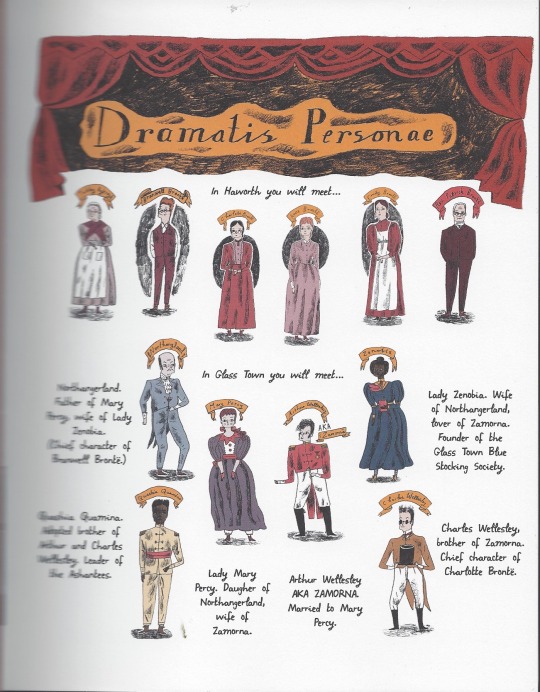
Greenberg’s art in Glass Town is crude in the same way ND Stevenson’s and Gus Allen art work is. If anything it’s more childlike and inconsistent. I don’t love it, but I like how the lines work the limited pallet with a lot of dark, cool reds. It hints at the early industrial feel of their time period as well as the harsh climate of their surroundings.
The narrative starts in the aftermath of the the eldest Brontë sisters, Elizabeth and Maria, deaths. The creation of Glass Town is an escape from the trauma of their final illnesses at a poorly kept boarding school.
Charlotte narrates her tale of Glass Town, to a minor character from her stories who appears as her imaginary friend. They talk through the plot she worked on, which as presented here seems more related to Wuthering Heights than Charlotte’s actual novels. The story includes how while the children started sharing Glass Town, they split with Charlotte and Bramwell writing about Angria while Emily and Anne created Gondor. (Less of Emily and Anne’s writing on Gondal survives to the modern day than Charlotte’s work on Angria, hence why less of it is included in either of these accounts.) Probably because of this shared fantasy world with her brother, Charlotte is shocked by his decent into alcoholism while Emily catches early warning signs. It’s a rumination on the building of escapist fantasy in the face of tragedy and the creation of art. I don’t think it entirely works, but it makes me want to get back to reading the Brontë’s and writing about them.
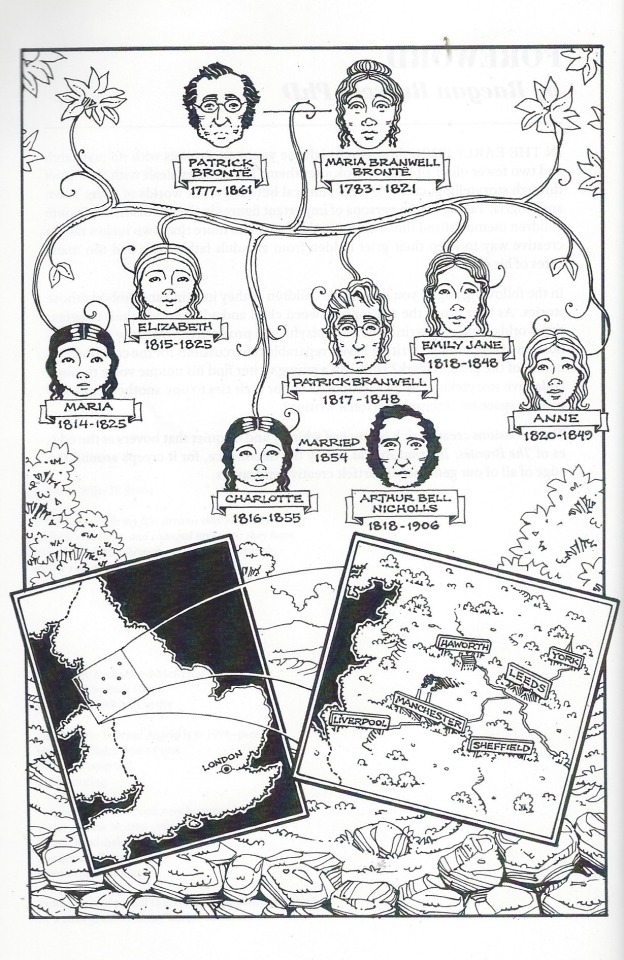
Infernal Angria takes the shared fantasy world and creates an actual portal fantasy. The Brontës literally go between worlds and get used in political machinations in an alternate world’s monarchy. I hated it. The text is something of an apologia for Bramwell for being such a failure. He didn’t really fail, he was manipulated by much more mature people from a world he loved. Also it takes the “artists don’t die, they live through their art” to the extreme of the Brontës didn’t all die at shockingly young ages, they relocated to the other side of a portal. It’s silly and also unclear. It shouldn’t be both. The end had the author talking about his long love of the Brontës as well as a suggested reading list. Everyone in a while you find someone who has some shared enthusiasms but seem to
At first glance, I would think that Geary’s art style is more my type than Greenbergs. But eventually I hated it because the shading was made with a crosshatching that got too easily confused with patents used for fabrics or wood grains. It’s the shorter of these two books and the one that felt more like a chore to read.
The contrasting treatments of the the worlds of Angria/Glass Town is pretty interesting. The character in both have essentially the same back story, but as presented in Infernal Angria I didn’t feel like the narrative came off as a rough draft of Wuthering Heights. Glass Town treats the alternate world as a reflection on contemporary colonialism, while Infernal Angria approaches it as a pastiche of Medieval fantasy. It makes me wish I had read the source material even more.
Despite finding these books lacking, there will be more comic book takes on the Brontës in my reading future.
#comics#comic books#what i'm reading#Glass Town#The Brontës Infernal Angria#The Brontës#charlotte bronte#Bramwell Brontë#emily bronte#Anne Bronte#Isabel Greenberg#Craig Hurd-McKenney#Rick Geary
3 notes
·
View notes
Text
Comics Read 06/14- 25/2023
Over this period of time I read the first two collected volumes of Lumberjanes, “Beware the Kitten Holy” and “Friendship to the Max”. These written by ND Stevenson and Grace Ellis, the art is by Gus Allen, colors by Maarta Laiho and letters by Aubrey Aiese. Shannon Watters is also credited as a creator.
This is an example of series that I know I am supposed to love, but I don’t really like. I read the first four or five issues as floppies as they came out back in 2014. I did not love them and wondered why. Was I just too old for this all ages comic? Did having to wait a month between issues take from my enjoyment because I did not feel things cumulatively? I gave the first issue away to a kid I was baby sitting to see if it was an age thing. She declared it “too scary” and lost the physical issue. I sold the rest in my eBay store and decided to trade wait to see if it was more enjoyable without the monthly issues. While I did buy these two volumes, part of me thought this was silly and didn’t continue and then waited almost a decade to actually read them. I should just accept that there are some popular things that I don’t like.

Now that I am even older, I am better at admitting that. Between then and now ND Stevenson’s other Nimona, and I think some of the things that rub me the wrong way about Lumberjanes were also present there. The characters act like they are fans of the series in which they are staring. They get excited about upcoming plot points like they would for reading or watching something, not as something they are going to live through. Part of why I find this off putting is they get excited like this so early that I have not gotten to a point where I care enough to be excited.
The format of each issues is to start with a page of the Lumberjanes Handbook. This handbook page ends mid sentence and then the story begins in media res, though not necessarily picking up where a cliff hanger left off. The final page of the issue also has a page of the handbooks this time with photos of the campers. The floppy versions included playlists created by the characters, but that did not get included with my trade paperbacks.
The plot of these volumes involves campers, their counselor who they always frustrate, and something supernatural going on in the woods. When the cause of these magical events is finally explained it felt like an excuse for action without plot. It must be fun for someone else.
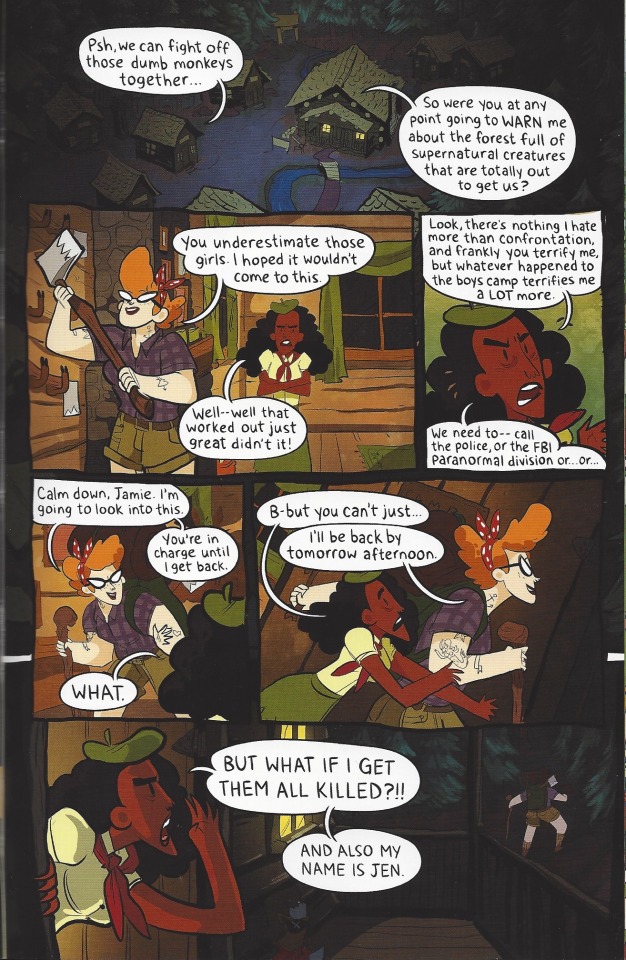
Allen’s art style is very like Stevenson’s. It is purposefully simple and child like. The colors are vivid and include a pretty wide palette for mostly flat colors. (That’s not a criticism, building depth through color would have been wrong for this kind of art.) The character designs are distinct enough to that various artist did impressive cover variants collected in the back that are all in their own distinct styles. But for the most part I didn’t feel like the characters were stood out as individuals. They are broadly drawn, but we learn so little of them in these volumes. Maybe this is a result of the issue structure? Also there is a reoccurring bit about Jen, the counsellor and only Black character in the book, being incorrectly named by Rosie the head of the camp. This is like the joke on Fringe about Walter never calling Astrid by her correct name, that the actress Jasika Nicole later admitted made her feel awful as a minority. It seems like it comes to a stop a the end of the second volume. And I hope it did, because it’s not fun to read.
#comic books#comics#what i'm reading#Boom Box Comics#lumberjanes#ND Stevenson#Grace Ellis#Gus Allen#Maarta Laiho#Aubrey Aiese#Shannon Watters#boom comics
2 notes
·
View notes
Text
Comics Read 06/4- 10/2023
Over this period of time I read Vagrant Queen a Planet Called Doom by Magdalene Visaggio, art by Jason Smith, colors by Harry Saxon, and letters by Zack Saam & Andworld Design. Came out at the same time as the short lived television series. I can’t say that the tv series was firing on all cylinders, but I can say that I wish it was renewed. It was fun, kooky and I really want there to be non- Star Wars and Star Trek space opera shows on television.
But as for the comic, I enjoyed it. There was something of time jump between the first volume and this so it didn’t really matter that it’s been years since I read it and I barely remember it. If the first volume (and the television show) could at sometime feel pro-monarchy by being so revolution-skeptical, this is the antidote. I’d plot is kickstarted by someone kidnapping the title Vagrant Queen, Elida, trying to reinstate her for their own purposes. The cult that the kidnapper leads to empower a new monarchy is funny sad. I won’t reveal who the
In my post about the first volume I said something about the art reminding me of Howard Chaykin’s American Flagg! I would not say that bout this volume. The panels are exciting, but bigger and no where near as busy as it would take for me to make that comparison. Also it has a pretty warm color pallet, even in the cold of space. There is a wild cliffhanger and I hope that it is revisited sometime soon.
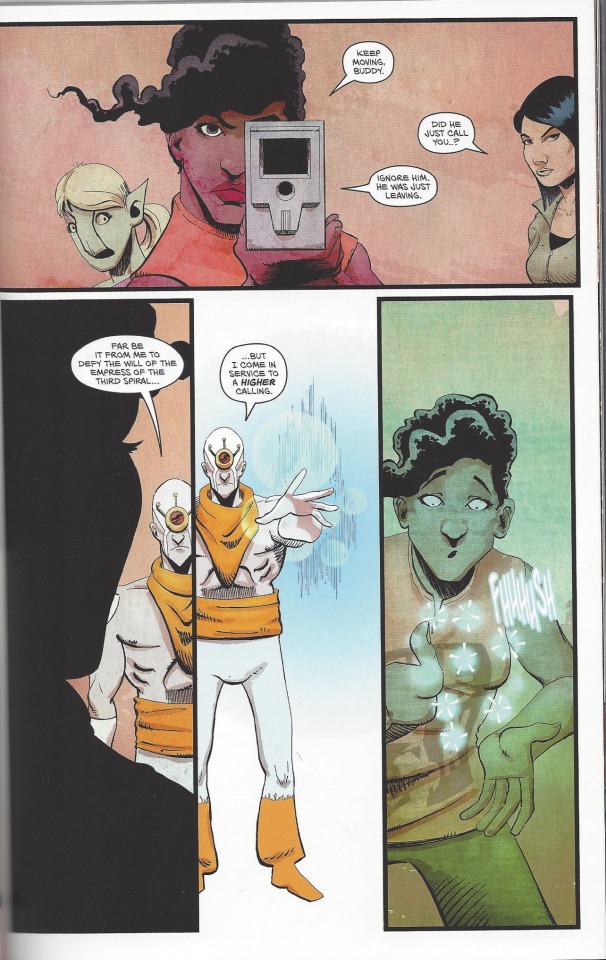
#comic books#what i'm reading#vault comics#vagrant queen#Vagrant Queen a Planet Called Doom#Magdalene Visaggio#Jason Smith#Harry Saxon#Zack Saam#andworld design
3 notes
·
View notes
Text
Comics Read 05/12-29/2023
Last time I posted, I forgot to put the photo of the current to read stack here it is, with the top two books already read.
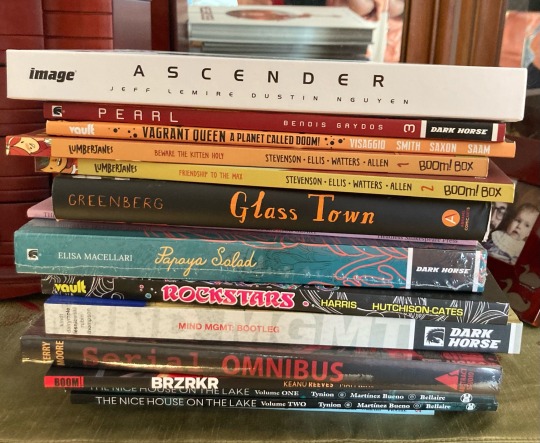
Over this period of time I read Pearl volume 3 by Brian Michael Bendis and Michael Gaydos. If you have been reading a lot of this blog, you may remember me writing about the first two volumes which I read as monthly floppies as they came out about four years ago. Again the gap since I last read Pearl means I have barely any memory of what happened in it’s plot or most of the supporting characters. My earlier posts say that I thought of it as a book that existed for the artist to draw subjects that excite him. While that is still true to a certain extent, this feels much more plot heavy.

From what memories I do have of the first two arcs, Pearl’s relationship to her late mother was important. Her mother taught her tattooing, was a warm presence, if also a Yakuza boss. The new arc has more to do with her living father, who is somehow responsible for the mother’s death. Wet this responsibility mentioned in the first two arcs? I think so but I am not certain.
What I am certain about is that Pearl’s romance with her boyfriend Ricky was touching then, and underused here. There is also a difficult to follow plot involving the FBI and rival Yakuza families.
The art here is incredible. The drawing has some near photographic detail in the drawing, with mostly non specific coloring choices that are atmospheric, full of interesting texture that adds to the drawing.
I have to re-read the whole series before deciding if I want more of it.
#what i’m reading#comic books#brian michael bendis#michael gaydos#dark horse comics#jinx comics#pile of books
1 note
·
View note
Text
Comics Read 04/16-05/10/2023
Over this period of time I read the Ascender Deluxe Edition by Jeff Lemire and Dustin Nguyen. It is a sequel to the creator’s earlier, Descender. I read that about three and a half years ago, also in Omnibus format, and wrote at little about back then. I do wish I wrote more. My desire to avoid accidentally spoiling someone and upsetting them is at odds with my desire to have notes that actually jog my memory.
Very little of Ascender jogs my memory of Descender. The appearance of the “dog” Bandit does a little, but I don’t remember if his backward bark (“fra” instead of “arf”) is a new thing or consistent with what came before.The main character of this one is Mila, the daughter of Andy and Effie and I don’t remember their stories at all. Andy was Tim-21’s human companion, and Effie’s character design has her mostly machine in a human machine hybrid. It’s tragic looking, and which hat suits her arc here but I don’t remember any explanation of her look. In general I remember Descender as an episodic picaresque, where I could enjoy moment to moment, but not really explain what it was about in a large sense.
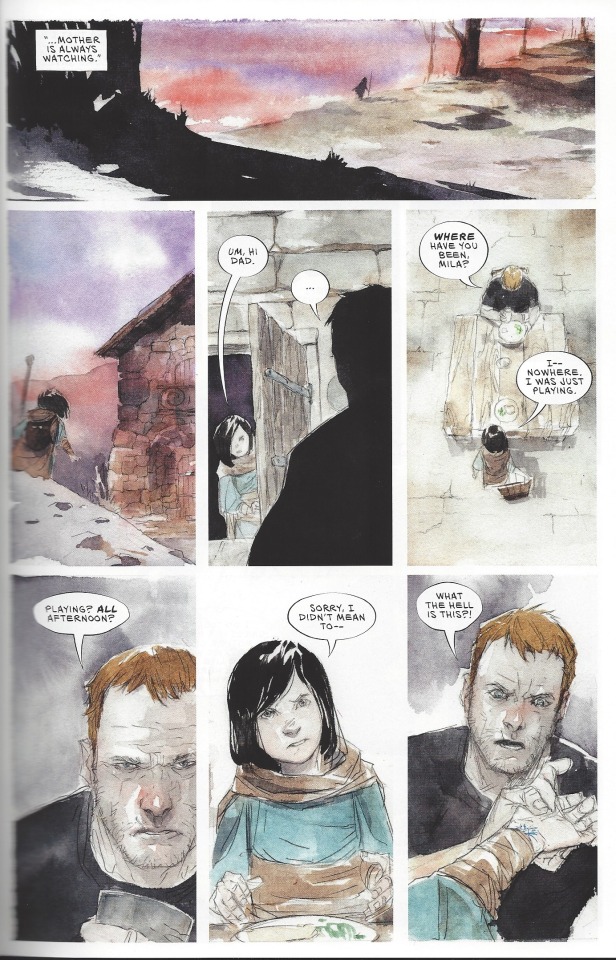
How important is it remembering Descender to enjoying Ascender? I’d say really important as many of the original cast of characters return one by one over the course of the story. When the robot Driller showed up I remembered that there was a robot named Driller who was enthusiastic about drilling and spoke in a mechanical looking font, but nothing about his character arc. When Dr. Quon showed up I remembered that he made everyone uncomfortable he was sort of a mad scientist, though mostly not harmful. These were mostly explained in Ascender too, so what I’m really saying is, their appearances here felt right. But I can’t say that seeing them again gave me any emotional excitement.
There is a quote on the back of the edition attributed to Comics Bookcase that says, “As Descender was to hard sci-fi, Ascender is to high fantasy…”. It actually has a magic versus science plot, where vampire invaders have banned the existence of machines. The vampires here are magical colonizers led by one known as Mother. The colonization metaphor is extended by having characters state that those converted to vampirism are “saved”, the same language as converts to Christianity. This sounds heavy handed when I describe it, but there is also a plot about Mother battling for power within her original family that resists this kind of allegorical interpretation.
I generally really enjoy Nguyen’s art, especially when colored by watercolor. It is very clean and easy to read while always having interesting things going on. The only time I didn’t like the art was with the Mother’s family, which uses a red wash to suggest magic, and it seems to come at the expense of clarity. I also generally like Nguyen’s panel work more that one or two page spreads. They were beautiful but required more engagement in the plot than I had. One of my goals with this blog is to better focus on the art while discussing comics criticism. I wish I had more to say here.
4 notes
·
View notes
Text
Comics Read 04/03-12/2023
Over this time period I read Lure written and drawn by Lane Milburn. I need to talk some more about how I ended up deciding to read and buy this. It was essentially an impulse buy when I was regularly preordering through the Midtown Comics app. If I had not come across it that way, I am not sure how or if I would have found it. Prior to the pandemic, I would go to the Comic shop weekly, and choose mostly singly issues of things that I regularly followed, though I tended to move towards trade paperback waiting as time went on. When the pandemic started, I moved to pre-ordering through the app. Many of the series I was reading in single issues ended or went on hiatus, and I continued to switch to trade collections as well searching for more things in the “Independents” section where the creators, or just cover and title intrigued me. Eventually, I lost interest in this. Partially because some thingsI preordered kept being pushed back, partially because I disliked some things chosen like this, but also because I have an impressive to read collection, and I am only getting to it now.
I did like Lure. I like how much of it is sci-fi landscapes. The passages of landscapes reminded me of Here by Richard McGuire, which was really unexpected. As for the parts of the book with people. The depiction of the insecurities of the artistic classes life felt real. I enjoyed being with the characters and seeing their situation get reflected in their work.
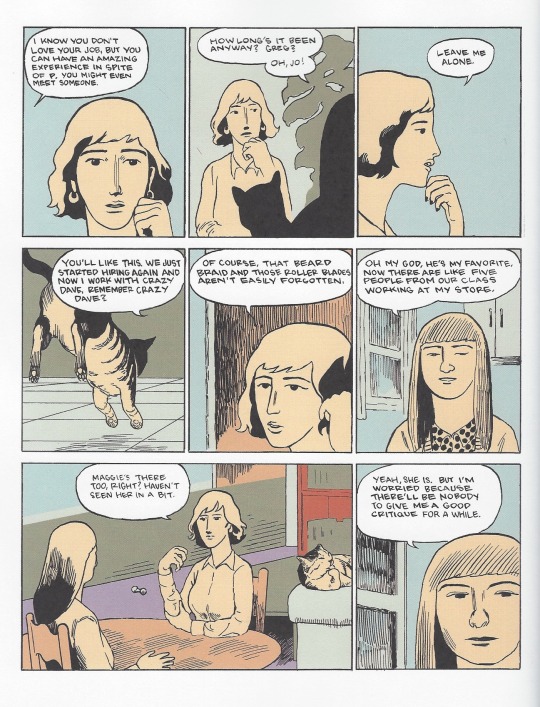
Interesting use of color. All the characters are peach like in coloring with black outlines. There is no shading, and all of the colors are flat. (Though it could be better with racial representation, the lack could also purposefully add to the sense that something is terribly wrong.) But the variety and use is pretty dream like and evocative. Over the course of reading it I’d find myself remembering a scene and being shocked that I came across it in comic form, not something filmed with audio. There isn’t much plot, and I have seen it described as “mumblecore” on Goodreads. I don’t know if I’d ever describe anything as “mumblecore”. But it does get the feeling of trying to keep living during this time of climate crisis, and for that I recommend it.
2 notes
·
View notes
Text
Comics Read 03/12- 04/02/2023
Over the course of this period in time I mostly didn’t read comics until at the last minute I finally got around to Lazarus Risen #7 written by Greg Rucka with art by Michael Lark. There are so many delays in starting this issue. There have been about a year and a half since I last read an issue of Lazarus Risen, and that might be the last time I read anything in single issue format. Pandemic times has continued to change what and when I consume of comics. As I no longer pre-order, I was months late to buying this issue and then weeks late to actually reading it.
Considering all that, it was a pretty good issue for the circumstances in which I read it. Most of the action involved the patriarchs of the Carlile and Hock recounting the origin of their enmity. Even though it involved the mysterious death of Hock’s sister, it felt a little too pat to involve everybody and everything it involved. But it was still a good read, with a surprise ending.

The art is good at keeping a mostly talky scenes moving and I like the muted use of colors. It makes the oppressive atmosphere and the occasional breaks from the pallet really stand out.
This is the last issue of the series as Lazarus Risen, though it will continue in some other format at an unannounced time. I wonder if I’ll have the opportunity to reread everything before that.
1 note
·
View note
Text
Comics Read 02/21-03/12/2023
Over this time period I read Alison Bechdel’s The Secret to Superhuman Strength. Long time readers of this blog may remember that when I was starting the transition for re-reading comics to first reads I was slowly making my way through Bechtel’s The Essential Dykes to Watch Out For. I was impressed by how she seemed to have a knack for catching and having her characters comment on the news that would most resonate through the future. This is more autobiographical than the earlier strip, and does cover her habits while making the comic strip, but does not directly comment on the content or what inspired it. However, there are regular reminders of the political figures of the times throughout the book. I also didn’t realize how long she worked on the comic after leaving the scene that supposedly inspired it.
One thing that jumped out as I started to read is that there was more color than I associate with Bechtel’s work work. In her earlier memoir, Fun Home there is a memorable moment where her father criticizes her coloring choices and you realize that she is still choosing the same limited pallet ones for the book you are reading. It’s a great moment of understanding what the medium of comics can represent psychologically. The use of color became less surprising when it’s absence was used for moments where she felt enlightened and transcendent.
While I am praising the book for it’s visuals I want to draw attention to the great use of text to help guide ones eye around the page. It makes all the less noticeable recent reads seem less great, let alone when it’s attempted and done badly.
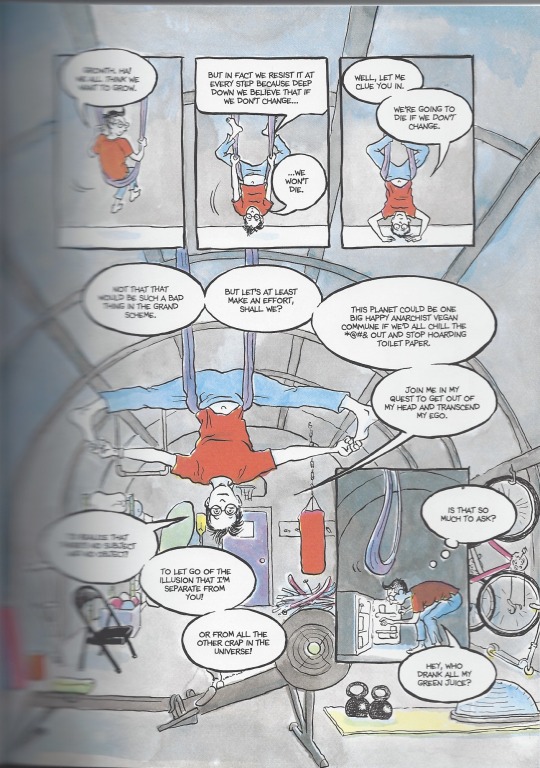
I started the book feeling pretty similar to Bechdel on the subject of athletics, and became less sit went on. As a person who hated gym class as a kid, but is devoted to voluntary gym classes as an adult, I am interested in people with similar experiences. Bechdel and I have some overlap in exercise interests, but not much. She is a life long devoted skier. I tried twice and while the second time was okay, the first was awful. Anyway, I don’t like being outside in the cold. I am devoted to swimming laps, and she barely mentions them. She also has a complicated but mostly positive relationship with running, and I hate it. In general, when she’s devoted to a kind of exercise, she’s singularly devoted, while I am more willing to base my choices on variety. Writing notes to base this entry on the experience of reading this was odd.
Somewhat surprisingly, this book about the relationship to exercise includes more discussion of drug and alcohol than in her previous autobiographical books, Fun Home and Are You My Mother? combined. It relates to when it does or does not feel like it works with her intense work out routines, and how it helps. It was interesting how even sobriety was obviously influenced by who she was living with and when.
Speaking of Bechtel’s earlier memoirs, I have to say, Margaret Fuller and Jack Karouac are to The Secret To Superhuman Strength what Donald Winnicott is to Are You My Mother? meaning earlier writers who I have never gotten around to reading and everything I know about them comes from these books. I’m not sure I ever will get around to the. But while I am more aware of where I am lacking in some readings, these books make interesting and intense reflections on each other, and I intend to keep reading them as long as she keeps making them.
#What I'm reading#What I'm not reading#alison bechdel#The Secret to Superhuman Strength#Fun Home#Are You My Mother?#dykes to watch out for#comicbooks#comics#comic memoirs
3 notes
·
View notes